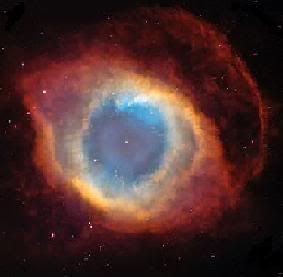|
|
Post by glactus on Jan 31, 2009 4:15:27 GMT
 The Helix nebula The Helix, NGC 7293, is a large planetary nebula located in the constellation of Aquarius. It was discovered by Karl Ludwig-Harding, probably before 1824. This object is one of the closest of all the bright nebulae to the Earth. The estimated distance is about 700 light-years. Variable magnitude is 13.5 Often referred to as the 'Eye of God', the Helix is an example of a nebula formed at the end of a star's evolution. Gases from the star in the surrounding space appear, from our vantage point, as if we are looking down a helix structure. The remnant central stellar core, known as a planetary nebula nucleus or PNN, is destined to become a white dwarf star. The observed glow of the central star is so energetic that it causes the previously expelled gases to brightly fluoresce. The Helix Nebula is thought to be shaped like a prolate spheroid with strong density concentrations toward the filled disk along the equatorial plane, whose major axis is inclined about 21° to 37° from our vantage point. We see the outer-most ring as flattened on one side due to its colliding with the ambient interstellar medium. Expansion of the whole planetary nebula structure is estimated to have occurred in the last 6,560 years, and 12,100 years for the inner disk. Spectroscopically, the outer ring's expansion rate is 40 km/s, and about 32 km/s for the inner disk.  Credits: This is a NASA/ Hubble image. |
|